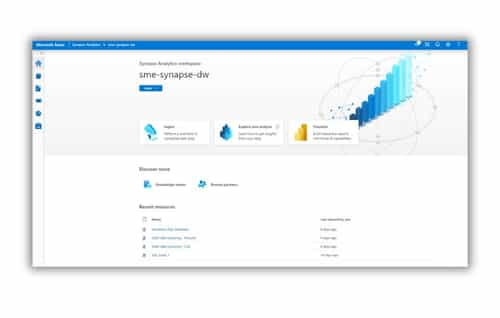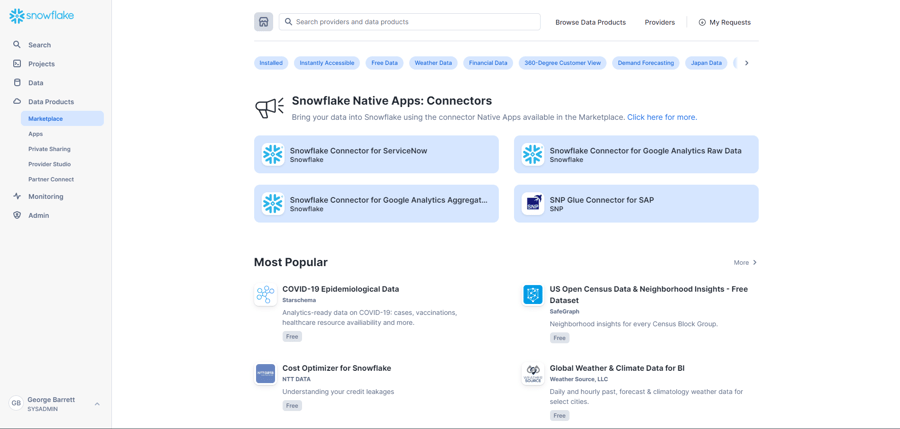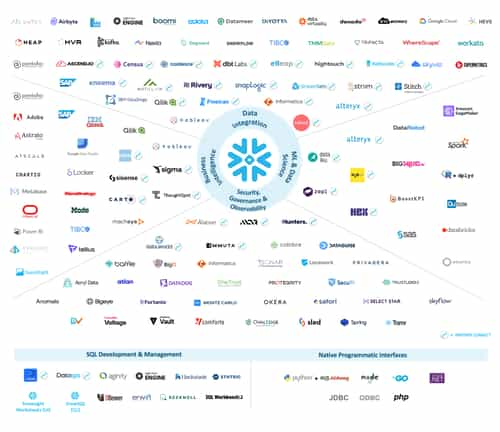In the dynamic realm of cloud data warehouses, choosing the right platform can be a pivotal decision for businesses aiming to leverage big data for strategic insights. Azure Synapse and Snowflake emerge as frontrunners, each bringing distinct strengths to the table. This comparison delves into the nuances of Data Sharing, User Experience, and Ecosystem to provide a comprehensive overview, guiding organizations in making an informed choice that aligns with their data management and analytical objectives.
Specifically, we will explore:
- the differences in user interfaces and management functionalities
- the query languages supported by both platforms
- data sharing capabilities
- the technology partner ecosystems

Azure Synapse vs. Snowflake: Cloud Services/User Experience
User experience in regard to cloud data warehouses encapsulates the overall interaction and satisfaction users have when engaging with these platforms. This encompasses the ease and intuitiveness of navigating the platform's interface, the efficiency with which data can be accessed, manipulated, and analyzed, and the customization options available that allow users to tailor the environment to their specific needs. It also involves the system's performance and scalability, ensuring that queries are processed swiftly and the platform can handle varying data volumes without lag. Furthermore, user experience covers the quality of support and documentation provided, enabling users to overcome challenges and maximize the platform's value. Security features that protect data integrity and compliance with regulatory standards are also integral to a positive user experience, ensuring trust and safety. In essence, user experience in cloud data warehouses is about making complex data operations simple, secure, and efficient for users, regardless of their technical expertise.
Snowflake's cloud services and user experience are exemplified by Snowsight, a state-of-the-art browser-based console that offers a seamless and intuitive platform for managing all Snowflake operations. With Snowsight, users can effortlessly execute queries, organize scripts, fine-tune Snowflake settings, monitor operations in real-time, and easily provision or modify warehouses to meet their specific needs.
 In contrast, Synapse's cloud services and user interface are highlighted by the Synapse Studio, which not only mirrors the robust functionalities of Snowsight but also integrates advanced data integration capabilities through Azure Data Factory (ADF) and seamless connectivity with Microsoft Power BI for comprehensive data analytics. However, the administrative process within Synapse may appear complex at times due to its dependence on the Azure Portal for certain operational tasks.
In contrast, Synapse's cloud services and user interface are highlighted by the Synapse Studio, which not only mirrors the robust functionalities of Snowsight but also integrates advanced data integration capabilities through Azure Data Factory (ADF) and seamless connectivity with Microsoft Power BI for comprehensive data analytics. However, the administrative process within Synapse may appear complex at times due to its dependence on the Azure Portal for certain operational tasks.
The intricate balance of cutting-edge technology and user-friendly interfaces in both Snowflake and Synapse ensures a dynamic user experience tailored to meet the diverse needs of data professionals in today's rapidly evolving digital landscape.
Key Takeaway: While Azure's integration of Data Factory in the Azure Studio is commendable, the seamless connection Fabric's console offers with other Azure tools is noteworthy. However, Snowflake stands out for its user-friendly administration process, making it easier to manage compared to Azure's split admin duties across various platforms.
Azure Synapse vs Snowflake: Query Languages
The significance of query languages in selecting a cloud data warehouse lies in their fundamental role in facilitating data interaction and extraction of insights. A user-friendly and widely-recognized query language, such as SQL, can democratize data access, enabling users of varied technical backgrounds to efficiently engage with the data. The sophistication of the query language directly influences the performance and efficiency of data operations, supporting complex analytics and manipulations within the warehouse itself. Additionally, the flexibility and scalability offered by advanced query languages ensure that the warehouse can adapt to evolving data structures and analytics needs. Seamless integration with other data analysis and business intelligence tools extends the utility of the data warehouse across different business functions. Moreover, languages that enable advanced analytics, like predictive modeling and real-time processing, empower organizations to harness their data more strategically.
Snowflake and Synapse both offer a robust set of query language options to enhance the user experience. While both platforms primarily support SQL for querying data, they also provide extensibility features for users to further customize their data operations.
In Snowflake, users can harness the power of user-defined functions (UDFs) in various languages, including Java, JavaScript, Python, Scala, and SQL. Snowpark's developer environment opens up possibilities for building applications and interacting with Snowflake data using Java, Python, and Scala. This versatility in language support allows users to tailor their data processing workflows to meet their specific requirements.
On the other hand, Synapse allows users to create UDFs in Transact-SQL, a language commonly used in the Microsoft ecosystem. Leveraging Spark notebooks, users can leverage PySpark (Python), Spark (Scala), Spark SQL, .NET Spark (C#), and SparkR (R) to perform a wide range of data tasks within the Synapse environment. This diverse language support ensures that users have the flexibility to work with data in the most efficient and effective way possible.
Both Snowflake and Synapse prioritize extensibility and development options, catering to a wide audience of data professionals with varying language preferences. This emphasis on language diversity enhances the overall user experience, allowing for greater customization and optimization of data operations within each platform. .png?width=900&height=575&name=Azure%20Synapse%20vs%20Snowflake%20Snowpark%20and%20Synapse%20Notebook%20(3).png)
Key Takeaway: In terms of SQL capabilities, both platforms offer similar functionality. However, they cater to a diverse audience when it comes to extensibility and development options. Snowflake supports Java and JavaScript, while Synapse is compatible with .NET/C# and R. While Snowflake can utilize .NET and R through connectors, Synapse provides SDKs for Java and JavaScript. It's interesting to note that Synapse's languages are all based on the Spark framework, which may or may not be a deciding factor for users.
Azure Synapse vs Snowflake: Data Sharing/Marketplace
Data sharing and marketplaces are pivotal in selecting a cloud data warehouse because they significantly enhance collaboration, foster innovation, and facilitate informed decision-making. Through robust data-sharing capabilities, organizations can seamlessly share insights and datasets with stakeholders, enhancing collaborative efforts and aligning strategies. Access to a vast array of external datasets via data marketplaces enriches internal analytics, offering new insights and perspectives critical for a competitive edge. This capability accelerates innovation by enabling companies to leverage diverse datasets to develop or refine new services. Additionally, ensuring that data sharing upholds strict compliance with privacy regulations and governance policies is essential, safeguarding sensitive information while fostering an environment of trust. Integrating data sharing and marketplaces into a cloud data warehouse extends its utility beyond traditional storage and processing, making it a hub for strategic collaboration and insight generation.
Snowflake's data-sharing capabilities provide a seamless and dynamic way for users to share selected objects within their accounts. The ability to share live views of original data ensures that any updates or changes made on the provider side are immediately reflected on the consumer side, allowing for real-time collaboration and data synchronization. Additionally, users have the option to take snapshots of the data in their accounts, providing a snapshot of the data at a specific point in time for reference or analysis.
Moreover, Snowflake's Marketplace offers a diverse range of data sets categorized by industry, function, and more, allowing organizations to easily list and share their data with others either for a fee or free of charge. This marketplace not only facilitates data sharing but also serves as a hub for applications built on Snowflake, further expanding the platform's capabilities and offerings.

On the other hand, Azure Data Share in Synapse provides users with the ability to send and receive data shares through snapshots that are transferred to the consumer account. While this method does not offer real-time views into the data like Snowflake, it still enables efficient data sharing and collaboration within the Synapse environment. However, unlike Snowflake, the Azure Marketplace for Synapse primarily focuses on applications rather than a dedicated data marketplace, showcasing a slight difference in the approach to data sharing and accessibility between the two platforms.
Key Takeaway: Snowflake's data sharing capabilities offer a seamless and dynamic approach, allowing users to access real-time views of data and create snapshots for reference. The Data Marketplace within Snowflake simplifies data acquisition without the need for ETL processes, with popular connectors like Stripe and ServiceNow gaining traction among users.
Azure Synapse vs Snowflake: Technology Partner Ecosystem
The technology partner ecosystem is a pivotal consideration when selecting a cloud data warehouse, as it directly influences the platform's integration capabilities, access to innovative technologies, and overall adaptability to an organization's unique needs. A rich ecosystem ensures seamless compatibility with a broad array of data ingestion, analytics, and business intelligence tools, enabling a cohesive data management architecture. It also opens doors to the latest advancements in analytics and AI, offering organizations a competitive edge in leveraging data for strategic decisions. The diversity within the ecosystem caters to various industry-specific requirements and regulatory standards, ensuring tailored solutions are readily available. Ultimately, a strong partner network enhances the scalability and flexibility of the data warehouse, ensuring it can evolve with the business and continuously meet changing data demands, thereby amplifying its value and impact on the organization's data-driven capabilities.
 Snowflake's extensive partner ecosystem is a testament to its industry leadership and commitment to providing a comprehensive suite of solutions in Data Integration, Business Intelligence, Security, Governance, Observability, ML & Data Science, and Application Development. With a diverse range of partners, Snowflake ensures that users have access to a wide array of tools and services to enhance their data operations and analytics capabilities.
Snowflake's extensive partner ecosystem is a testament to its industry leadership and commitment to providing a comprehensive suite of solutions in Data Integration, Business Intelligence, Security, Governance, Observability, ML & Data Science, and Application Development. With a diverse range of partners, Snowflake ensures that users have access to a wide array of tools and services to enhance their data operations and analytics capabilities.
As a cloud data warehouse pioneer, Snowflake's integrations and features take precedence in the market, often being prioritized ahead of other cloud data warehouse offerings. The platform's cloud agnostic approach further strengthens its position by allowing seamless integration with technologies from major cloud providers such as AWS, Azure, and GCP, providing users with unparalleled flexibility and scalability in their data management strategies.
On the other hand, Synapse's partner network, driven by its association with Microsoft, also boasts a robust lineup of partners across similar domains as Snowflake. While Synapse covers the same areas of Data Integration, Business Intelligence, Security, Governance, Observability, ML & Data Science, and Application Development, its integrations with certain technologies may sometimes take a backseat compared to leading platforms like Snowflake, Databricks, and Google BigQuery. This positioning is partly due to Synapse's reliance on the Microsoft Azure ecosystem, limiting its ability to leverage tools and services from other cloud providers like AWS or GCP.
Key Takeaway: It's worth noting that Snowflake primarily serves as a cloud data warehouse, relying on its partners to cover various aspects of the ecosystem. In contrast, Microsoft offers its own toolsets for ETL, data integration, and data cataloging within the Synapse environment. This dynamic has led some tech companies to prioritize integrations with other cloud data warehouses over Synapse. For instance, Sigma has opted not to integrate with Synapse, citing a preference for Power BI among Synapse customers. Similarly, Matillion has indicated that due to the strong Microsoft customer base, they tend to focus on tools like Azure Data Factory instead of Synapse. These insights highlight the differing perspectives on Synapse and Microsoft tools, showcasing the varying opinions among users, especially data engineers who may have different preferences, such as favoring Snowflake, Fivetran, dbt, and other tools.
Conclusion
Navigating the complexities of cloud data warehouses requires a nuanced understanding of each platform's offerings, especially when comparing leaders like these platforms; Azure Synapse and Snowflake consulting experts can make this easier. While both platforms offer robust capabilities in data sharing, user experience, and ecosystem support, our expert analysis leans towards Snowflake as the preferred option for most organizations. Snowflake stands out with its on-demand scaling capabilities and strategic cost optimization, providing businesses with unparalleled control and adaptability in managing data workloads. Though Synapse Studio presents compelling integration features for data management, Snowflake's flexible architecture and efficiency in handling diverse query languages for advanced functionalities make it a versatile and powerful choice. Ultimately, the decision hinges on aligning the platform's strengths with your organization's specific needs, ensuring that your chosen data warehouse propels your data-driven strategies forward.
.png?width=700&height=127&name=Blue%20Mantis%20formerly%20known%20as%20SME%20Solutions%20Group%2c%20Inc.%20(GREEN).png)

